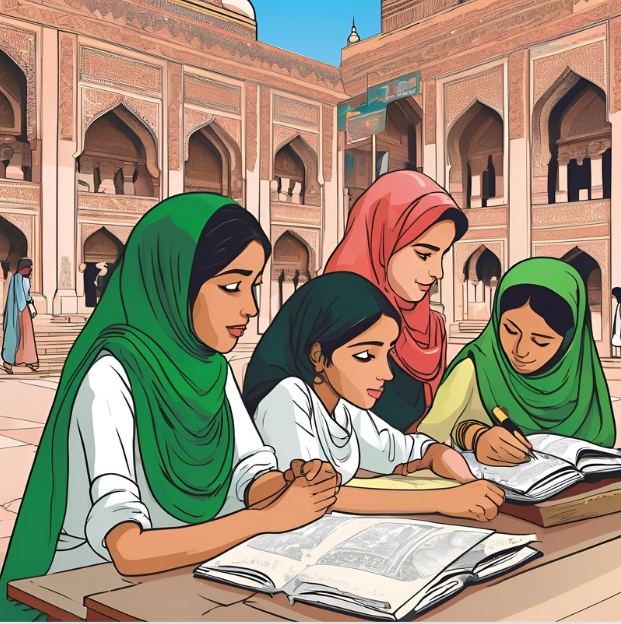
Abstract
This research explores the experiences of South Asian Muslim girls studying abroad, focusing
on Pakistani, Indian, and Bangladeshi backgrounds. Utilizing a comparative approach, the
study investigates adaptation strategies and perceptions of cultural identity through qualitative
data collection methods. Non-probability sampling targeted South Asian Muslim girls abroad.
Qualitative methods (interviews, focus groups) gathered insights.
Participants are chosen for relevance and willingness. Semi-structured sessions explored challenges and adaptation.
Predominantly Hungarian participants (14), with some from the USA and Turkey. Thematic
analysis identified key experiences, informing cultural adaptation among participants. Findings
reveal diverse social environments and religious practices among the participants. Pakistani
girls perceive competitiveness, Bangladeshi girls feel isolated, while Indian girls experience
inclusivity abroad.
Despite challenges, South Asian girls maintain cultural and religious connections, often expressed through wearing hijab. Financial management skills vary, with Bangladeshi girls showing less comfort. Scholarship support is prevalent, impacting academic performance differently. Pakistani girls perceive better educational opportunities. The research
highlights individual experiences and perceptions, emphasizing the importance of contextual factors in cultural adaptation.
This study contributes to the discourse on diversity, multiculturalism, and international education, providing insights into the different experiences of South Asian Muslim girls abroad.
Keywords : South Asian Muslim Girls, Cultural identity, Adaptation strategies, Qualitative data,
educational opportunities.
Introduction
South Asian Muslim girls often come from conservative and traditional families with distinct
cultural norms, values, and social boundaries. These cultural practices dictate specific
principles, etiquette, and behavioral expectations. The girls studying abroad in a Western
country navigates between their cultural identity and the unfamiliar environment. This situation
becomes more complex if a girl carries a hijab. The attire worn by Muslim girls can
significantly impact their experiences abroad.
Thus, the choice of attire can affect social integration, acceptance, and opportunities for engagement within diverse cultural settings outside of their native environment. The University of Oxford broke history by enrolling the
first student (British Pakistani in the Bachelor of Civil law), wearing Niqab in its 900-year
history since its founding in 1096(The Islamic Information, 2021). The aim of this paper is to
give a voice to Muslim girls studying abroad and helps raise awareness about their unique
circumstances.
The paper contributes to the academic discourse on diversity, multiculturalism,
and international education. It adds to existing literature by providing insights into the
experiences of Muslim girls studying abroad and enriches the understanding of cross-cultural
education. South Asian girls transitioning from Eastern to Western attire and removing their
hijab for adjustment abroad, while those who retain their Eastern attire face challenges in
adapting to the new environment, sometimes leading to misunderstandings and apprehension
from others.
To better understand these situations, I conducted a cross- sectional survey The
survey focused on the current situation and circumstances faced by these girls to find the factors
such as cultural diversity, acceptance of religion and social norms influence their adaptation
strategies and perceptions of cultural identity. This comparative approach can highlight the
importance of contextual factors in shaping individual experiences.
Statement of problem
The Problem to be addressed through this study is in recent years, an increasing number of
South Asian Muslim girls have pursued higher education abroad, seeking opportunities for
personal and professional growth beyond their home countries. However, abroad, these girls
often encounter perceptions that label them as different, particularly those who choose to wear
hijab and niqab, facing social, cultural, and economic marginalization.
This isolation can lead to the compromise of their religious practices. Addressing this issue is crucial to understanding
the socio-cultural challenges impacting their educational experiences and well-being.
Additionally, the comparative analysis across India, Pakistan, and Bangladesh is lacking,
leaving unanswered questions about the influence of socio-cultural contexts and national
policies on the educational development of South Asian Muslim girls.
This research aims to fill this gap by conducting a comprehensive comparative analysis of the socio-cultural,
economic lifestyle, and challenges faced by South Asian Muslim girls studying abroad. Unlike
existing literature primarily focusing on hijab, our research considers broader socio-cultural
and economic challenges faced by South Asian Muslim girls.
Methodology
A non-random sampling method was employed to select participants for this study, focusing
on South Asian Muslim girls studying abroad. Qualitative data collection techniques, such as
interviews and focus groups, were utilized to gather rich and different insights into the
experiences of these individuals. Participants were selected based on their willingness to
participate and their ability to provide valuable perspectives on the topic.
Semi-structured interviews and focus group discussions were conducted to explore the participants’ current
situations, challenges, and adaptation strategies in detail. Most participants are from Hungary,
Europe, comprising 14 respondents, with additional participants from the USA and Turkey. The
qualitative data obtained from these sessions were analyzed thematically to identify common
themes, patterns, and variations in the participants’ experiences.
This approach allowed for a deeper understanding of the factors influencing cultural adaptation and identity among South
Asian Muslim girls studying abroad.
Research Objectives
➢ To examine the socio-cultural perception and attitudes towards South Asian Muslims
girls studying abroad.
➢ To analyze the economic challenges faced by these girls abroad.
➢ To conduct a comparative analysis of the educational trajectories by these girls studying
abroad across India, Pakistan, and Bangladesh.
Research Questions
1- How do these socio-cultural perceptions and attitudes influence social interactions.
2- What are the primary economic challenges encountered by these girls abroad?
3- How do employment opportunities differ from other international students?
4- How do educational experiences of South Asian Muslim girls studying abroad differ
across India, Pakistan, and Bangladesh.
5- What are the similarities and differences in the challenges faced by these girls abroad?
Social lifestyle

Cultural lifestyle

Economic lifestyle

Opportunities

Pakistani girls perceive better educational opportunities compared to their counterparts in India
and Bangladesh. While some Indian and Bangladeshi girls feel that the educational
opportunities are almost similar across the board, others believe they have even better
opportunities. Notably, none of the girls express having had a worst experience in terms of
educational opportunities.
These varied perspectives suggest that while Pakistani girls view the educational landscape
more favorably, there is a range of opinions among Indian and Bangladeshi girls regarding the
quality of opportunities available to them abroad. This diversity of experiences highlights the
importance of individual circumstances and perceptions in shaping one’s assessment of
educational opportunities in foreign settings.
Discussion and suggestions
All three nationalities maintain a strong connection to their culture and religion. Economic
management skills displayed, but Bangladeshi girls express less comfort with financial matters.
Financial concerns impact academics differently among the girls, with most Bangladeshi girls
reporting influences due to financial stress. Pakistani girls perceive better educational
opportunities compared to Indian and Bangladeshi girls.
Additionally, there are various Muslim girls studying abroad, but my survey was limited to those within my contact circle.
Observations suggest that most South Asian girls studying abroad are on scholarships and feel
comfortable in the foreign environment. They are often able to carry their hijab and abayas,
although the ease of this varies from country to country. Furthermore, it is noted that abroad
environments offer a safer setting for girls compared to many South Asian countries, as many
prefer to explore cities rather than stay home.
Consequently, families need not be overly concerned about their daughters’ safety. However, it is essential to acknowledge that my analysis is based on a small sample size of eighteen respondents, primarily from Europe.
Therefore, there may be additional differences to consider if data were collected from regions
such as Australia, Africa, Russia, Saudi Arabia, Dubai, significant parts of America, and
Türkiye. In my survey, only one respondent was from Türkiye, and three were from the USA.
Conclusion
The research reveals that South Asian girls abroad, particularly those from Pakistan, India, and
Bangladesh, have diverse experiences in terms of their social environment, religious practices,
and financial management. Pakistani girls perceive the atmosphere abroad as competitive,
while Bangladeshi girls report feeling isolated and unfriendly, and Indian girls experience a
friendly and inclusive environment. South Asian girls maintain a strong connection to their
culture and religion, actively engaging in religious rituals, with the prevalence of hijab among
them indicating a commitment to religious expression.
Despite the challenges of being away from their home countries, many South Asian girls find ways to uphold their cultural and religious traditions, contributing to the rich tapestry of diversity in their adopted communities
abroad. Most South Asian girls residing abroad take charge of their finances, displaying their
financial management skills, although Bangladeshi girls express less comfort with financial
matters. A significant portion of South Asian girls abroad hold scholarships, highlighting their
academic prowess and resourcefulness in securing financial aid.
The impact of financial concerns on academics varies among South Asian girls, with most girls from Bangladesh
reporting influences on their academic performance due to financial stress, while very few from
India share this sentiment. Pakistani girls perceive better educational opportunities compared
to their counterparts in India and Bangladesh, while there is a range of opinions among Indian
and Bangladeshi girls regarding the quality of opportunities available to them abroad.
This diversity of experiences highlights the importance of individual circumstances and perceptions
in shaping one’s assessment of educational opportunities in foreign settings.
References
- Haj-Yehia, K., & Erez, M. (2018). The impact of the ERASMUS program on cultural identity: A case study of an Arab Muslim female student from Israel. Women’s Studies International Forum, 70, 32–38. https://doi.org/10.1016/j.wsif.2018.08.001
- Is it safe for a Muslim woman who wears a hijab to travel to Europe to study? (n.d.). Quora. Retrieved March 6, 2024, from https://www.quora.com/Isit-safe-for-a-Muslim-women-who-wears-a-hijab-to-travel-to-Europe-tostudy.
- Oxford University Enrolls First Niqab Wearing Student in 900 years. (2021, November 8). https://theislamicinformation.com/news/the-first-studentwearing-niqab-enrolls-at-oxford-university-in-their-900-year-history/
- Reflections on Studying Abroad as a Muslim Woman. (n.d.). Diversity Abroad. Retrieved March 6, 2024, from https://www.diversityabroad.com/articles/reflections-studying-abroadmuslim-woman.
- What is lifelike for a foreign student Muslim girl, as a hijabi abroad like Europe, America, or in non-Muslim countries? I have been liv… (n.d.). Quora. Retrieved March 6, 2024, from https://www.quora.com/What-islife-like-for-a-foreign-student-Muslim-girl-as-a-hijabi-abroad-likeEurope-America-or-in-non-Muslim-countries-I-have-been-living-in-Saudi-Arabia-for-10-years-now-I-want-to-go-study-abroad-but-I-want-toknow
- Zine, J. (2006). Unveiled Sentiments: Gendered Islamophobia and Experiences of Veiling among Muslim Girls in a Canadian Islamic School. Equity & Excellence in Education, 39(3), 239–252. https://doi.org/10.1080/10665680600788503




